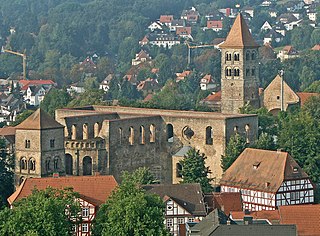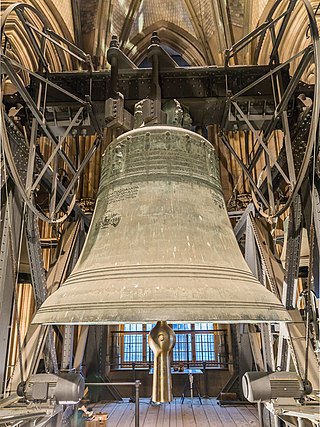
The Liberty Bell, previously called the State House Bell or Old State House Bell, is an iconic symbol of American independence located in Philadelphia. Originally placed in the steeple of Pennsylvania State House, now known as Independence Hall, the Liberty Bell today is located across the street from Independence Hall in the Liberty Bell Center in Independence National Historical Park.

The festival and spa town of Bad Hersfeld is the district seat of the Hersfeld-Rotenburg district in northeastern Hesse, Germany, roughly 50 km southeast of Kassel.

Campanology is the scientific and musical study of bells. It encompasses the technology of bells—how they are founded, tuned and rung—as well as the history, methods, and traditions of bellringing as an art.

The Sigismund Bell is the largest of the five bells hanging in the Sigismund Tower of the Wawel Cathedral in the city of Kraków, Poland. It was cast in 1520 by Hans Behem and named after King Sigismund I the Old, who commissioned it. The bell weighs almost 13 tonnes and requires 12 bell-ringers to manually swing it. It tolls on special occasions, mostly religious and national holidays, and is regarded as one of Poland's national symbols.

A bell is a directly struck idiophone percussion instrument. Most bells have the shape of a hollow cup that when struck vibrates in a single strong strike tone, with its sides forming an efficient resonator. The strike may be made by an internal "clapper" or "uvula", an external hammer, or—in small bells—by a small loose sphere enclosed within the body of the bell.

A church bell is a bell in a church building designed to be heard outside the building. It can be a single bell, or part of a set of bells. Their main function is to call worshippers to the church for a communal service, but are also rung on special occasions such as a wedding, or a funeral service. In some Christian traditions they signify to people outside that a particular part of the service has been reached.
Bellfounding is the casting and tuning of large bronze bells in a foundry for use such as in churches, clock towers and public buildings, either to signify the time or an event, or as a musical carillon or chime. Large bells are made by casting bell metal in moulds designed for their intended musical pitches. Further fine tuning is then performed using a lathe to shave metal from the bell to produce a distinctive bell tone by sounding the correct musical harmonics.

Russian Orthodox bell ringing has a history starting from the baptism of Rus in 988 and plays an important role in the traditions of the Russian Orthodox Church.

St Peter's Cathedral is a Roman Catholic church and former cathedral in Worms, southern Germany.

A "ring of bells" is the name bell ringers give to a set of bells hung for English full circle ringing. The term "peal of bells" is often used, though peal also refers to a change ringing performance of more than about 5,000 changes.

Hersfeld Abbey was an important Benedictine imperial abbey in the town of Bad Hersfeld in Hesse, Germany, at the confluence of the rivers Geisa, Haune and Fulda. The ruins are now a medieval festival venue.

A cowbell is a bell worn around the neck of free-roaming livestock so herders can keep track of an animal via the sound of the bell when the animal is grazing out of view in hilly landscapes or vast plains. Although they are typically referred to as "cow bells" due to their extensive use with cattle, the bells are used on a wide variety of animals.

Petersglocke, commonly referred to as Dicker Pitter, is the largest bell in Cologne Cathedral. It was cast in 1923 by Heinrich Ulrich in Apolda and hangs in the belfry of the south tower. With a weight of approximately 24,000 kilograms (53,000 lb), a clapper weighing about 700 kilograms (1,500 lb) and a diameter of 322 centimetres, it is the second largest freely swinging ringable bell in the world, after the bell of the People's Salvation Cathedral in Bucharest, Romania.

Veronese bell ringing is a style of ringing church bells that developed around Verona, Italy, from the eighteenth century. The bells are rung full circle, being held up by a rope and wheel until a note is required.

Bonshō, also known as tsurigane or ōgane are large bells found in Buddhist temples throughout Japan, used to summon the monks to prayer and to demarcate periods of time. Rather than containing a clapper, bonshō are struck from the outside, using either a handheld mallet or a beam suspended on ropes.

The Justice Bell is a replica of the Liberty Bell made in 1915. It was created to promote the cause for women's suffrage in the United States from 1915 to 1920. The bell is on permanent display at the Washington Memorial Chapel in Valley Forge National Park in Pennsylvania.

There are 10 church bells in the cathedral of Notre-Dame de Paris, all of which are mounted in the two main bell towers. Notre-Dame used to have other smaller bells in the spire and within the roof, but these were destroyed in a fire in 2019.
MDR Rundfunkchor is the radio choir of the German broadcaster Mitteldeutscher Rundfunk (MDR), based in Leipzig, Saxony. Dating back to 1924, the choir became the radio choir of a predecessor of the MDR in 1946, then called Kammerchor des Senders Leipzig, or Rundfunkchor Leipzig. The present name was established in 1992. The choir has appeared internationally, and has made award-winning recordings.

The Miguelete Tower is the bell tower of the Valencia Cathedral in Valencia, Spain. It is known as El Miguelete in Castilian Spanish or Torre del Micalet in the Valencian language. Construction of the tower began in 1381 and was completed in 1429. Due to its complexity and long years of construction, it was successively directed by several master builders; the first being Andreu Juliá, from 1381. Others were José Franch (1396), Pedro Balaguer ; to Martí Llobet (1425), the last of the architects to work on the construction. Subsequently, the belfry was added (1660-1736).

The Linde in Schenklengsfeld, also known as the Schenklengsfeld Dorflinde or Riesenlinde, is a thousand-year-old linden tree and is considered one of the oldest trees in Germany. This large-leaved lime tree is located in Schenklengsfeld, approximately ten kilometers southeast of Bad Hersfeld in the eastern Hessian district of Hersfeld-Rotenburg. Throughout its history, this tree served as a court lime tree, where legal proceedings and gatherings took place for several centuries. Additionally, a pillory was constructed near the tree for carrying out sentences.


















